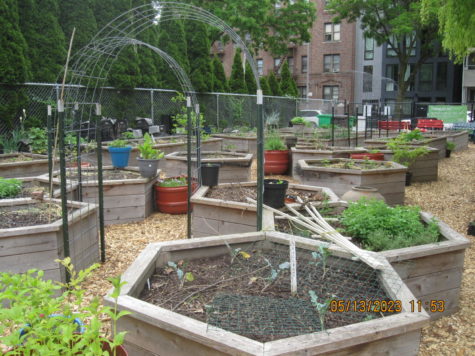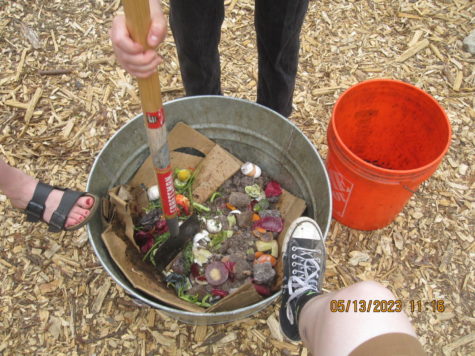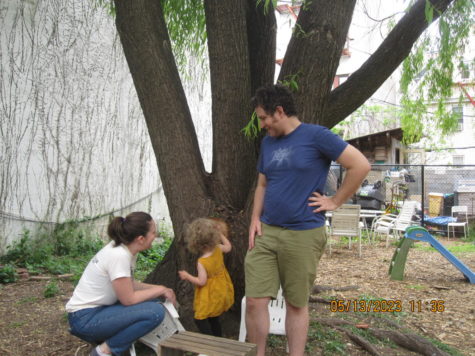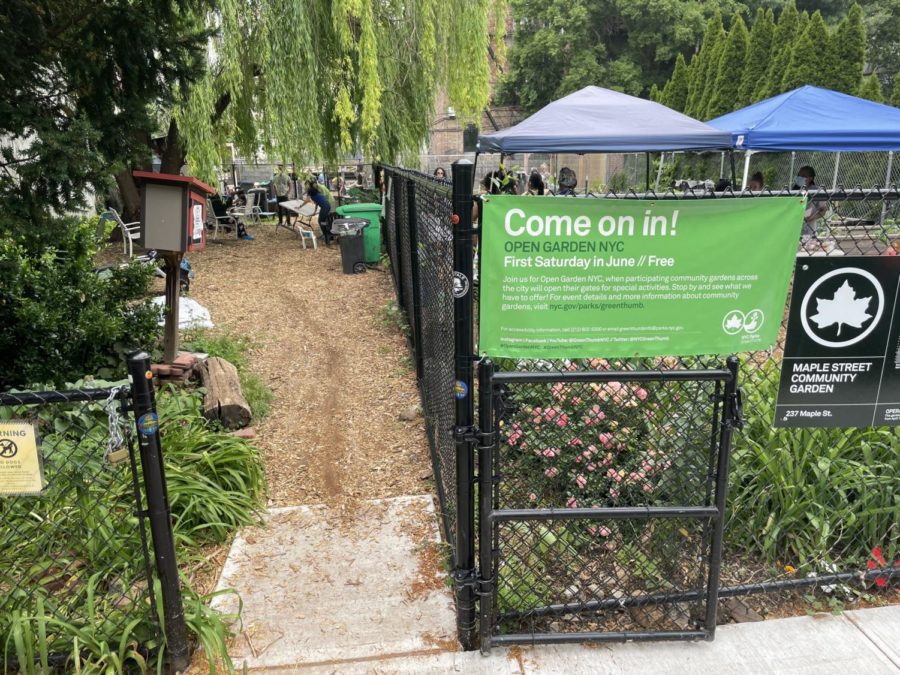A Labor of Love: The Maple Street Community Garden
From a 1997 fire on Maple Street to a 2023 Saturday compost shift, this garden is both the beacon and the symbol of the Prospect Lefferts Gardens community in the Flatbush area of Brooklyn.
The Maple Street Community Garden welcomed residents from all over the city on June 3rd, 2023 for activities and games.
Brooklyn is a community. All towns and cities are communities, to an extent, and New York City is of course its own community, but Brooklyn has always been a bit special in this regard.
I still remember my first block party. We kids all got free ice creams from the truck parked across the street from my house, and a group of police officers brought over a climbing wall. The fire hydrant at the end of the street spewed water, and we raced through it, shouting. That night we had a potluck. At least a hundred of us all sat at tables covered in plastic tablecloths covered on tables that were piled high with food. Everyone brought dishes, most of them homemade. My dad had worked on his chili for days beforehand, letting it simmer, as he tailored the taste to his liking. We ate, and once we were full, we danced – we must have been out past 9 p.m. It was the first time I’d felt like a part of a community.
Block parties have dulled, now, given the Coronavirus pandemic over the past three years, and the fact that kids on the block have grown up, but even when Brooklyn’s community changes, it never dies. There are book clubs and hair salons and restaurants and parks. If you walk down Rutland Road in Brooklyn, you’ll always see a few people sitting on their stoops with a book or a mug of coffee. And, if you’re in Prospect Lefferts Gardens (PLG) and you really want to feel the heart of our community, you can always visit the Maple Street Community Garden.
The Maple Street Community Garden (MSCG) is located between Rogers and Nostrand Avenues in the Flatbush section of Brooklyn, New York City. For years it’s been a hub and a greenspace, but many PLG residents simply know it as a compost location. The MSCG is vital to the neighborhood’s sense of community. It’s visited by dozens of volunteers and passers-by every week. Some just stop by to drop off compost, some work in garden plots, and some take their kids to the small play area on the left side of the lot.
THE FIGHT FOR THE GARDEN
The land wasn’t always a garden, though — 237 Maple Street used to be a home. By 1997, both of the owners were deceased. That year, a fire broke out, and although there were no casualties, the house burned to the ground. The vacant lot left behind remained untouched for over a decade, during which time it was slowly filled with litter. Multiple mattresses and tarps were scattered across the property, sometimes hidden by the overgrown grass and blooming weeds. It was inhabited by pests, garbage, stray cats, and the occasional unhoused person, which is to say that its inhabitants were not particularly interested in upkeep.
In the summer of 2012, fifteen years later, PLG residents were looking for a way to come closer together. They wanted a place to gather, a place to interact with nature, and a place for kids to play outside. Perhaps most importantly, they wanted a place they had built for themselves and each other, with their own hands, in their own neighborhood. What they found was 237 Maple Street.

A few residents applied for a $1,000 grant from the city for the project – every additional cent was raised by the community. They set up shifts and working hours, along with a compost collection system. They built raised plant beds where anyone, not just those who paid for a plot, could grow vegetables and herbs.
The garden came together as a community space, and it did so almost entirely independent from outside forces. This was not a business endeavor, or a greenspace carefully planned by the New York City Parks Department. These were the summer plans of a group of people who wanted to better their community.
That independence proved to be dangerous in 2014. Tim Nottage, a compost co-captain at the Maple Street Community Garden, told me about the garden’s battle with predatory real estate. “The garden’s changed a lot since I started working here, in both physical form and ability,” said Nottage. “We weren’t part of the Parks Department until 2019, so until then, we were cut off from the kinds of resources we have now. That was fine for a while, but in 2014 – about two years before I started working here – a real estate company tried to take the garden.”
The company that Nottage is talking about was owned by brothers Joseph and Michael Makhani. The Makhanis have a history of illegal and predatory real estate practices. In 1999, the brothers pleaded guilty to “taking part in a scheme involving foreclosed properties in Queens,” after they were sued for price jacking and contract breaches that put multiple community members in danger of losing their homes. They served three months in jail.
In 2008, they pleaded guilty again to “filing false deeds as a part of a housing scam in Queens,” and paid $15,000 in fines. Neither punishment seems to have deterred them.
Less than five years later, the brothers used the same tactics to try to steal the Maple Street Community Garden. A Rachel Smith article for DNAInfo NYC says that the brothers did have a deed (falsified or not) for the lot, allegedly bought for $10 in 2011, but no permit applications were filed with the Department of Buildings. A Bill Weinberg article for AMNY, alternately, notes that the Makhani brothers had passed a 2003 deed (showing a purchase of the lot for $5,000) between two shell companies. The deed lists the seller as the heirs of the house’s original owners and was allegedly notarized in “Worchester, Massachusets” – both location names are spelled wrong in the document.
What is the one thing every report of the event agrees on? The Makhani brothers didn’t have any legal claim to the plot.
That didn’t stop them from trying to make the property their own. On September 22nd, 2014, Joseph and Michael Makhani went to the garden, tore down signs and tried, unsuccessfully, to force garden volunteers to leave. They drove a truck into the garden and started breaking down the risen plant beds. Garden workers called the police, who ordered the Makhani brothers off the property when they were unable to provide documentation of ownership. Tom La Farge, an MSCG gardener who passed away in late 2022, was working that day. When asked why the police sided with the gardeners, La Farge said, “They know us. Not them.” The gardeners were active PLG community members – the real estate con artists were not.
For the next several years, the garden was in fight mode.
Volunteers kept up garden work until late July, when the court closed the garden to both the gardeners and the Makhani’s while deciding how to proceed. For several days, volunteers sat in folding chairs outside the gates to strategize ways to get the garden back. Gardeners began to consider convincing the city to take the land by eminent domain, a process by which the government can repurpose private land for public use. After six weeks, the court ruled that the gardeners had squatters rights and could continue gardening until the case of who owned the land was settled.
Garden organizers worked on a legal defense of the lot. Bob Treuber gathered signatures for a petition to save the garden. Paula Segal, a lawyer, took on the MSCG case (and the case of another nearby garden also fighting deed theft) pro bono. The organizers also hired a third-party company to find any heirs to the lot, but could not find them by the initial court date. Later on, they were able to find legitimate heirs to the property. Those heirs are currently in court petitioning New York City for money the city set aside for them.
In 2019, New York City took the land by eminent domain — a huge victory for the garden.
Tim Nottage quantified the importance of government aid to the garden. “I don’t think anyone understood how much of a difference it would make to work with the parks department,” he explained. “We have access to so many things, now. It’s possible to build infrastructure and get grants. We couldn’t have things like the fresh food box program when we weren’t an official New York City park. The fight to keep the park was a big turning point for us.”
THE GARDEN’S NEW LIFE
Six years later, the garden remains a community hub. “It’s never been just a garden,” said Marc Schwartz, the husband of compost shift leader Liora Schwartz. The MSCG hosts a Harvest Fair every fall, and although potlucks have been less frequent since the Coronavirus pandemic, Nottage is hopeful that they’ll happen semi-regularly again soon.
“I actually found out about the garden on my first day in the city, through one of our potlucks. A friend invited me, I came, it was amazing, and I started volunteering here a few months later. Those potlucks were a lot of people’s introduction to the garden, not just mine,” Nottage said.
MCSG’s ability to offer the range of activities and resources it does is in large part due to its three-section layout. The first and largest section contains raised plant beds. This is the section where volunteers usually work, whether it is in compost shifts on Wednesdays and Saturdays, or gardening shifts throughout the week.

Julia Dutch, a compost volunteer, has been working in the garden section for a few months. “I’ve really only done a few shifts here, but I love it,” Dutch said. “I’ve been in PLG for three years now. It’s the most community-feeling neighborhood I’ve lived in here in Brooklyn – I wanted another way to connect to it.” The idea of giving back to the neighborhood is a common sentiment from MSCG volunteers and frequenters.
Dutch added that her concern about gentrification in Brooklyn, and in PLG specifically, also motivates her involvement with MSCG. “I’m part of the problem, I know, so I want to do as much as I can to give back. I shop at local shops and family-run stores, and I volunteer here. It’s a start – there’s always more to do, but it’s a start,” she explained.
Another volunteer has a slightly different story. “My school has a required number of volunteer hours, so at first, this was a way to fill those hours,” admitted Beacon High School rising junior Asher Cohen. “I’ve been here for seven months now, and I love it. I’m going to keep working here over the summer and as much as I can next year.”
Even when he first started, though, Cohen cared deeply about the garden. “The other reason that I decided to start volunteering here was that I was in this big environmental nihilism spiral. I felt like I couldn’t make a difference, and I thought the best way to fix that would be to work in a garden. Every time I come here, I can literally see the progress we’re making, and it’s given me so much hope.”
Cohen is well known among other volunteers – he’s the only current gardener to work every weekend, which means he’s at the garden even more than even the shift leaders. He also knows everyone who comes in by name. “It’s been so amazing to see people from the garden around PLG. I ran into this woman at the grocery store a few weeks ago, and we recognized each other and chatted for a few minutes – the garden is definitely the best way I’ve gotten to know my neighbors,” Cohen said.

The second section, occupying about a third of the garden’s width, is the ‘park.’ It holds a gorgeous tree, a small, rustic playset, and a few benches, and it is usually frequented by parents of young children. Rachel Small and Gregg Altman are two such parents. They have lived in Prospect Lefferts Gardens for two years now, and Small described the neighborhood as the “perfect mix of everything,” given its proximity to Prospect Park, its independent businesses, and its sense of community.
They have been bringing their compost to the garden for a while, but when I saw them, they were playing on a slide with their young daughter. She seemed happy – fascinated by the large, weeping willow tree overhead, and shyly intrigued by the gardeners. “She loves it here, in this neighborhood, for really the same reasons we do, even though obviously she’d phrase it differently. She likes playing in the dirt, she likes seeing all the stores run by people we maybe know from down the street, she likes waving at neighbors on stoops – and she likes the garden,” said Altman, as he watched his daughter inspect some flowers.
The final and smallest section, just behind the ‘park’ area, is where the garden’s compost gets stored. At least, it’s where the compost they collect on Wednesday gets stored – scraps collected on Saturday go to a larger composting facility at Big Reuse. “It was amazing when we realized that we were actually taking in more compost than we could process,” Tim Nottage said. “We now get about 20,000 pounds of food and plant waste given to us by community members each year.”
The compost that they do keep, however, is put into containers in the back of the garden, by the maintenance shed. While Nottage walked through the containers, he talked a bit about the importance of having compost facilities like this one. “The best thing we do here is divert food scraps from landfills. Organic waste is around 30% of our waste stream, and when that waste goes through our normal garbage processing system, it doesn’t become the rich soil it does here.” When food and plant waste has fully morphed into rich soil, it’s used in the garden or distributed to neighborhood residents.
At the Maple Street Community Garden, talking to Tom and Asher and Julia and Gregg and Rachel, I feel the soul of my neighborhood stronger than I have since that first block party. A small group of people came together with an empty lot and a goal, and they built a shared resource for the neighborhood. This garden represents the power of PLG, and the power of Brooklyn – the power of any community, really.
The Maple Street Community Garden (MSCG) is located between Rogers and Nostrand Avenues in the Flatbush section of Brooklyn, New York City. For years it’s been a hub and a greenspace, but many PLG residents simply know it as a compost location. The MSCG is vital to the neighborhood’s sense of community. It’s visited by dozens of volunteers and passers-by every week. Some just stop by to drop off compost, some work in garden plots, and some take their kids to the small play area on the left side of the lot.
Acadia Bost is a returning Editor-in-Chief for ‘The Science Survey.’ Placing an emphasis in their writing on the more structural, long term problems...

